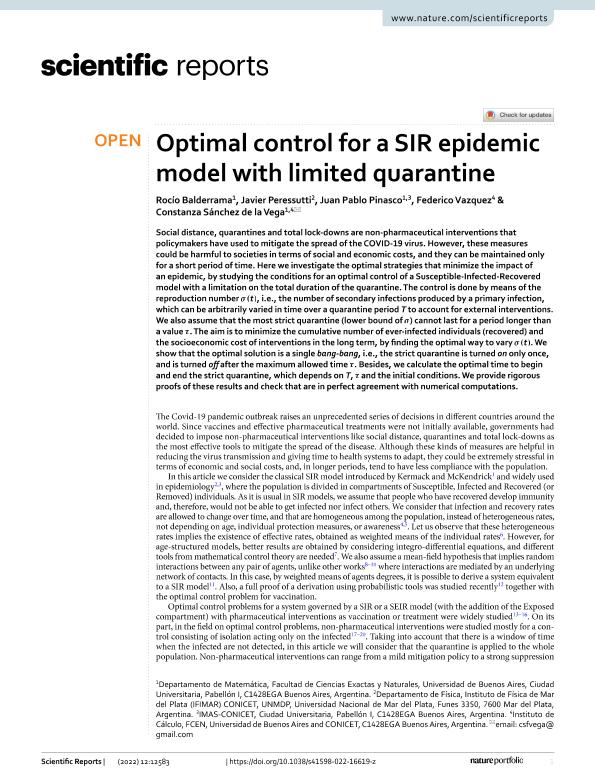Artículo
Optimal control for a SIR epidemic model with limited quarantine
Balderrama, Rocio Celeste ; Peressutti, Javier Hector
; Peressutti, Javier Hector ; Pinasco, Juan Pablo
; Pinasco, Juan Pablo ; Vazquez, Federico
; Vazquez, Federico ; Sanchez Fernandez de la Vega, Constanza Mariel
; Sanchez Fernandez de la Vega, Constanza Mariel
 ; Peressutti, Javier Hector
; Peressutti, Javier Hector ; Pinasco, Juan Pablo
; Pinasco, Juan Pablo ; Vazquez, Federico
; Vazquez, Federico ; Sanchez Fernandez de la Vega, Constanza Mariel
; Sanchez Fernandez de la Vega, Constanza Mariel
Fecha de publicación:
07/2022
Editorial:
Nature
Revista:
Scientific Reports
ISSN:
2045-2322
Idioma:
Inglés
Tipo de recurso:
Artículo publicado
Clasificación temática:
Resumen
Social distance, quarantines and total lock-downs are non-pharmaceutical interventions that policymakers have used to mitigate the spread of the COVID-19 virus. However, these measures could be harmful to societies in terms of social and economic costs, and they can be maintained only for a short period of time. Here we investigate the optimal strategies that minimize the impact of an epidemic, by studying the conditions for an optimal control of a Susceptible-Infected-Recovered model with a limitation on the total duration of the quarantine. The control is done by means of the reproduction number σ(t) , i.e., the number of secondary infections produced by a primary infection, which can be arbitrarily varied in time over a quarantine period T to account for external interventions. We also assume that the most strict quarantine (lower bound of σ) cannot last for a period longer than a value τ. The aim is to minimize the cumulative number of ever-infected individuals (recovered) and the socioeconomic cost of interventions in the long term, by finding the optimal way to vary σ(t). We show that the optimal solution is a single bang-bang, i.e., the strict quarantine is turned on only once, and is turned off after the maximum allowed time τ. Besides, we calculate the optimal time to begin and end the strict quarantine, which depends on T, τ and the initial conditions. We provide rigorous proofs of these results and check that are in perfect agreement with numerical computations.
Palabras clave:
SIR
,
COVID-19
,
Quarantine
Archivos asociados
Licencia
Identificadores
Colecciones
Articulos (IC)
Articulos de INSTITUTO DE CALCULO
Articulos de INSTITUTO DE CALCULO
Articulos(IFIMAR)
Articulos de INST.DE INVESTIGACIONES FISICAS DE MAR DEL PLATA
Articulos de INST.DE INVESTIGACIONES FISICAS DE MAR DEL PLATA
Articulos(IMAS)
Articulos de INSTITUTO DE INVESTIGACIONES MATEMATICAS "LUIS A. SANTALO"
Articulos de INSTITUTO DE INVESTIGACIONES MATEMATICAS "LUIS A. SANTALO"
Citación
Balderrama, Rocio Celeste; Peressutti, Javier Hector; Pinasco, Juan Pablo; Vazquez, Federico; Sanchez Fernandez de la Vega, Constanza Mariel; Optimal control for a SIR epidemic model with limited quarantine; Nature; Scientific Reports; 12; 1; 7-2022; 1-26
Compartir
Altmétricas



